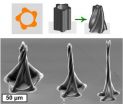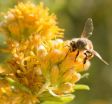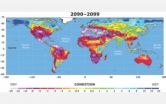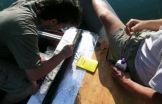(Press-News.org) ANN ARBOR, Mich.---Twisting spires, concentric rings, and gracefully bending petals are a few of the new three-dimensional shapes that University of Michigan engineers can make from carbon nanotubes using a new manufacturing process.
The process is called "capillary forming," and it takes advantage of capillary action, the phenomenon at work when liquids seem to defy gravity and travel up a drinking straw of their own accord.
The new miniature shapes, which are difficult if not impossible to build using any material, have the potential to harness the exceptional mechanical, thermal, electrical, and chemical properties of carbon nanotubes in a scalable fashion, said A. John Hart, an assistant professor in the Department of Mechanical Engineering and in the School of Art & Design.
They could lead to probes that can interface with individual cells and tissues, novel microfluidic devices, and new materials with a custom patchwork of surface textures and properties.
A paper on the research is published in the October edition of Advanced Materials, and is featured on the cover.
"It's easy to make carbon nanotubes straight and vertical like buildings," Hart said. "It hasn't been possible to make them into more complex shapes. Assembling nanostructures into three-dimensional shapes is one of the major goals of nanotechnology. The method of capillary forming could be applied to many types of nanotubes and nanowires, and its scalability is very attractive for manufacturing."
Hart's method starts by stamping patterns on a silicon wafer. His ink in this case is the iron catalyst that facilitates the vertical growth of the carbon nanotubes in the patterned shapes. Rather than stamp a traditional, uniform grid of circles, Hart stamp hollow circles, half circles and circles with smaller ones cut from their centers. The shapes are arranged in different orientations and groupings. One such grouping is a pentagon of half circles with their flat sides facing outward.
He uses the traditional "chemical vapor deposition" process to grow the nanotubes in the prescribed patterns. Then he suspends the silicon wafer with its nanotube forest over a beaker of a boiling solvent, such as acetone. He lets the acetone condense on the nanotubes, and then lets the acetone evaporate.
As the liquid condenses, capillary action forces kick in and transform the vertical nanotubes into the intricate three-dimensional structures. For example, tall half-cylinders of nanotubes bend backwards to form a shape resembling a three-dimensional flower.
"We program the formation of 3D shapes with these 2D patterns," Hart said. "We've discovered that the starting shape influences how the capillary forces change the structures' geometry. Some bend, others twist, and we can combine them any way we want."
The capillary forming process allows the researchers to create large batches of 3D microstructures---all much smaller than a cubic millimeter---over essentially limitless areas, Hart said. In addition, the researchers show that their 3D structures are up to 10 times stiffer than typical polymers used in microfabrication. Thus, they can be used as molds for manufacturing of the same 3D shapes in other materials.
"We'd like to think this opens up the idea of creating custom nanostructured surfaces and materials with locally varying geometries and properties, " Hart said. "Now, we think of materials as having the same properties everywhere, but with this new technique we can dream of designing the structure and properties of a material together."
INFORMATION:
The paper is called "Diverse 3D Microarchitectures Made by Capillary Forming of Carbon Nanotubes."
This research is funded by the University of Michigan College of Engineering and the U-M Department of Mechanical Engineering, the Belgium Fund for Scientific Research, and the National Science Foundation.
The university is pursuing patent protection for the intellectual property, and is seeking commercialization partners to help bring the technology to market.
For more information:
John Hart: http://www.mechanosynthesis.com/
Michigan Engineering:
The University of Michigan College of Engineering is ranked among the top engineering schools in the country. At $180 million annually, its engineering research budget is one of largest of any public university. Michigan Engineering is home to 11 academic departments and a National Science Foundation Engineering Research Center. The college plays a leading role in the Michigan Memorial Phoenix Energy Institute and hosts the world class Lurie Nanofabrication Facility. Find out more at http://www.engin.umich.edu/.
Intricate, curving 3-D nanostructures created using capillary action forces
2010-10-20
ELSE PRESS RELEASES FROM THIS DATE:
Gene activity in the brain depends on genetic background
2010-10-20
SEATTLE, Wash.—October 18, 2010—Researchers at the Allen Institute for Brain Science have found that the same genes have different activity patterns in the brain in individuals with different genetic backgrounds. These findings may help to explain individual differences in the effectiveness and side-effect profiles of therapeutic drugs and thus have implications for personalized medicine. The study is available in this week's online early edition of the Proceedings of the National Academy of Sciences (www.pnas.org).
In this study, the authors compared where in the brain ...
See no shape, touch no shape, hear a shape?
2010-10-20
Scientists at The Montreal Neurological Institute and Hospital – The Neuro, McGill University have discovered that our brains have the ability to determine the shape of an object simply by processing specially-coded sounds, without any visual or tactile input. Not only does this new research tell us about the plasticity of the brain and how it perceives the world around us, it also provides important new possibilities for aiding those who are blind or with impaired vision.
Shape is an inherent property of objects existing in both vision and touch but not sound. Researchers ...
Sniffing out shoe bombs: A new and simple sensor for explosive chemicals
2010-10-20
CHAMPAIGN, Ill. — University of Illinois chemists have developed a simple sensor to detect an explosive used in shoe bombs. It could lead to inexpensive, easy-to-use devices for luggage and passenger screening at airports and elsewhere.
Triacetone triperoxide (TATP) is a high-powered explosive that in recent years has been used in several bombing attempts. TATP is easy to prepare from readily available components and has been difficult to detect. It defies most standard methods of chemical sensing: It doesn't fluoresce, absorb ultraviolet light or readily ionize.
The ...
Old bees' memory fades; mirrors recall of mammals
2010-10-20
A study published Oct. 19 in the open access journal Public Library of Science (PLoS) ONE, shows that not just human memories fade. Scientists from Arizona State University and the Norwegian University of Life Sciences examined how aging impacts the ability of honey bees to find their way home.
While bees are typically impressive navigators, able to wend their way home through complex landscapes after visits to flowers far removed from their nests, the study reveals that aging impairs the bees' ability to extinguish the memory of an unsuitable nest site even after the ...
Drought may threaten much of globe within decades
2010-10-20
The United States and many other heavily populated countries face a growing threat of severe and prolonged drought in coming decades, according to results of a new study by National Center for Atmospheric Research (NCAR) scientist Aiguo Dai.
The detailed analysis concludes that warming temperatures associated with climate change will likely create increasingly dry conditions across much of the globe in the next 30 years.
The drought may reach a scale in some regions by the end of the century that has rarely, if ever, been observed in modern times.
Using an ensemble ...
Study reveals superior sedation method for children
2010-10-20
Procedural sedation and analgesia is an essential element of care for children requiring painful procedures in the emergency department. The practice of combining ketamine and propofol, two common medications used in emergency departments, has become more popular. However, until recently, it was unclear whether this practice was superior to the use of either agent alone, especially in children.
Research led by Drs. Amit Shah, Gregory Mosdossy and Michael Rieder of the Schulich School of Medicine & Dentistry at The University of Western Ontario and Lawson Health Research ...
Iowa State, USDA researchers discover eye test for neurological diseases in livestock
2010-10-20
AMES, Iowa – The eyes of sheep infected with scrapie – a neurological disorder similar to mad cow disease – return an intense, almost-white glow when they're hit with blue excitation light, according to a research project led by Iowa State University's Jacob Petrich.
The findings suggest technologies and techniques can be developed to quickly and noninvasively test for transmissible spongiform encephalopathies, progressive and fatal neurological diseases such as mad cow disease in cattle and Creutzfeldt-Jakob disease in humans. Petrich, in fact, is working to develop ...
Old logging practices linked to high erosion rates
2010-10-20
Clear-cut logging and related road-building in the 1950s and 1960s in southern Oregon's Siskiyou Mountains disrupted soil stability and led to unprecedented soil erosion made worse during heavy rainstorms, report University of Oregon researchers.
While logging practices have improved dramatically since then, the damaged landscape -- the removal of low vegetation that helps to protect hillsides during fires and rain -- continues to pose a threat into the foreseeable future, said Daniel G. Gavin, professor of geography, and postdoctoral doctoral researcher Daniele Colombaroli.
Their ...
The hair brush that reads your mind
2010-10-20
WASHINGTON, Oct. 19 – One of the main techniques for measuring and monitoring mental activity, called functional near infrared spectroscopy (fNIRS), can often be impaired because a person's hair gets in the way. But now, thanks to a team of researchers at the University of Texas at Dallas and the University of Texas at Arlington, a novel device called a "brush optrode" is providing increased sensitivity with fiber tips designed to thread through hair to enhance scalp contact.
Details of the device will be presented at the Optical Society's (OSA) 94th annual meeting, ...
Researchers advocate for more education and attention regarding rare breast cancer
2010-10-20
PHILADELPHIA (October 19, 2010)—Inflammatory breast cancer (IBC), an aggressive and rare malignancy, is often initially misdiagnosed as an infection or rash. However, getting the correct diagnosis quickly is critical for patients because the disease spreads beyond the breast in a matter of just days or weeks. With that in mind, leading specialists from The University of Texas MD Anderson Cancer Center and Fox Chase Cancer Center have written a review of the current scientific and medical understanding of IBC, which includes key information on diagnosis, imaging, treatment, ...




